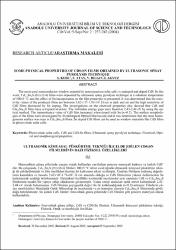| dc.contributor.author | Kose, S. | |
| dc.contributor.author | Atay, F. | |
| dc.contributor.author | Bilgin, V. | |
| dc.contributor.author | Akyuz, I. | |
| dc.date.accessioned | 2015-02-23T12:51:14Z | |
| dc.date.available | 2015-02-23T12:51:14Z | |
| dc.date.issued | 2004 | |
| dc.identifier.issn | 13023160 | |
| dc.identifier.uri | https://hdl.handle.net/11421/1513 | |
| dc.description.abstract | The most used semiconductor window material in heterojunction solar cells is undoped and doped CdS. In this work, Cd₁₋ᵪSnᵪS (0≤x≤0.4) films were deposited by ultrasonic spray pyrolysis technique at a substrate temperature of 300±5 °C and the effect of Sn incorporation on the film properties is presented. It was determined that the resistivity values of the produced films are between 3.62x10²-1.76x10⁷ Ω cm in dark and air and the high resistivity of CdS films decreased by Sn doping. The investigations on the electrical properties also showed that CdS and Cd₀.₈Sn₀.₂S films have a trapped structure. The forbidden energy gaps were found as 2.43-2,44 eV by using the optical method. The transmittance value of CdS film increased when doped with Sn (x=0.2). The surface morphologies of the films were investigated by Metallurgical Optical Microscope and it was determined that the most homogeneous surface was seen in Cd₀.₈Sn₀.₂S films. Sn doped CdS films can be used as window materials like CdS films in photovoltaic solar cells. | en_US |
| dc.description.abstract | Heteroeklem güneş pillerinde yaygın olarak kullanılan yarıiletken pencere materyali katkısız ve katkılı CdS’ dür. Bu çalışmada, Cd₁₋ᵪSnᵪS (0≤x≤0.4) filmleri 300±5 °C taban sıcaklığında ultrasonik kimyasal püskürtme tekniği ile çöktürülmüştür ve film özellikleri üzerine Sn katkısının etkisi verilmiştir. Üretilen filmlerin özdirenç değerlerinin karanlıkta ve havada 3.62x10²-1.76x10⁷ Ω cm arasında olduğu ve CdS filmlerinin yüksek özdirencinin Sn katkılanarak azaldığı belirlenmiştir. Elektriksel özellikler üzerindeki incelemeler aynı zamanda CdS ve Cd₀.₈Sn₀.₂S filmlerinin tuzaklı bir yapıya sahip olduklarını göstermiştir. Yasak enerji aralıkları optik metot kullanılarak 2,432,44 eV olarak bulunmuştur. CdS filminin geçirgenlik değeri Sn ile katkılandığında (x=0.2) artmıştır. Filmlerin yüzey morfolojileri Metaluıjik Optik Mikroskop ile incelenmiş ve en homojen yüzeyin Cd₀.₈Sn₀.₂S filmlerinde görüldüğü belirlenmiştir. Sn katkılı CdS filmleri fotovoltaik güneş pillerinde CdS filmleri gibi pencere materyali olarak kullanılabilir. | en_US |
| dc.language.iso | eng | en_US |
| dc.publisher | Anadolu Üniversitesi | en_US |
| dc.rights | info:eu-repo/semantics/openAccess | en_US |
| dc.subject | Photovoltaic Solar Cells | en_US |
| dc.subject | CdS and CdS:Sn Films | en_US |
| dc.subject | Ultrasonic Spray Pyrolysis Technique | en_US |
| dc.subject | Electrical | en_US |
| dc.subject | Optical and Morphological Properties | en_US |
| dc.subject | Fotovoltaik Güneş Pilleri | en_US |
| dc.subject | CdS ve CdS:Sn Filmleri | en_US |
| dc.subject | Ultrasonik Kimyasal Püskürtme Tekniği | en_US |
| dc.subject | Elektrik | en_US |
| dc.subject | Optik ve Morfolojik Özellikleri | en_US |
| dc.title | Some Physical Properties of CdS:Sn Films Obtained by Ultrasonic Spray Pyrolysis Technique | en_US |
| dc.title.alternative | Ultrasonik Kimyasal Püskürtme Tekniği İle Elde Edilen CdS:Sn Filmlerinin Bazı Fiziksel Özellikleri | en_US |
| dc.type | article | en_US |
| dc.relation.journal | Anadolu Üniversitesi Bilim ve Teknoloji Dergisi A - Uygulamalı Bilimler ve Mühendislik | en_US |
| dc.relation.publicationcategory | Makale - Ulusal Hakemli Dergi - Kategorisiz | en_US |


















